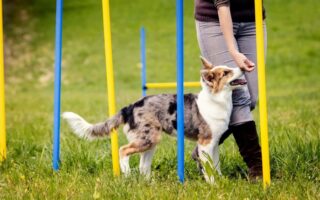Exploring the World of Dog Place Boards: A Path to Positive Training
In a world where the bond between humans and their four-legged companions continues to flourish, innovative tools and techniques are reshaping the landscape of canine training. Among these, the dog place board has emerged as a valuable resource for dog owners and trainers alike. This unassuming piece of equipment—a raised platform or board designed to encourage a dog to settle in a designated spot—opens up a realm of possibilities for enhancing focus, discipline, and relaxation in our furry friends. In this article, we will delve into the concept of dog place boards, their benefits, and how they can transform the way we communicate with and nurture our canine companions. Join us as we embark on a journey to discover the practical uses of this training tool and how it can foster a deeper understanding between you and your dog.
Table of Contents
- Understanding the Role of Dog Place Boards in Training
- Choosing the Right Materials for Optimal Dog Comfort
- Effective Techniques for Utilizing Dog Place Boards
- Enhancing Your Dog’s Learning with Interactive Play Activities
- Q&A
- In Summary
Understanding the Role of Dog Place Boards in Training
Dog place boards serve as powerful tools in the training arsenal of any dog owner. These specialized boards provide a designated area for dogs to learn commands such as “stay” and “place.” When training a dog, consistency is key, and having a specific spot where the dog is expected to go can simplify this process. With the right use of a place board, dogs can develop a clearer understanding of boundaries and expectations. This not only aids in reinforcing good behavior but also enhances the bond between the trainer and the dog, as both work together towards achieving a common goal.
A crucial aspect of using a place board effectively lies in the methodology surrounding its introduction. Successful training typically adheres to the following principles:
- Positive Reinforcement: Reward your dog with treats or praise when they correctly use the place board.
- Clear Commands: Consistently use specific commands such as “place” to guide your dog onto the board.
- Gradual Progression: Slowly increase the duration your dog stays on the board to build their confidence.
The following table summarizes the benefits and features of incorporating dog place boards in training:
| Feature | Benefit |
|---|---|
| Defined Space | Helps dogs understand boundaries. |
| Training Versatility | Applicable for various commands beyond “stay.” |
| Portability | Can be used indoors and outdoors. |
Choosing the Right Materials for Optimal Dog Comfort
When selecting materials for your dog’s place board, it’s essential to prioritize both comfort and durability. Every dog has unique needs, and the right fabric can enhance their lounging experience. Consider options that are soft yet sturdy, such as:
- Memory foam – Perfect for joint support, providing a cloud-like feel.
- Breathable mesh – Ensures airflow, keeping your pup cool during warmer months.
- Water-resistant fabrics – Ideal for easy cleaning and maintaining hygiene.
- Non-slip materials – Adds stability, preventing the board from sliding around during use.
Additionally, the structure and design of the place board play pivotal roles in your dog’s comfort. Utilizing a combination of materials can create an optimal lounging experience. Here is a simple table to illustrate the benefits of various materials:
| Material | Benefits |
|---|---|
| Memory Foam | Pressure relief and support for joints |
| Breathable Mesh | Excellent ventilation and comfort |
| Water-Resistant Fabric | Easy to clean and maintain |
| Non-Slip Base | Safer and more stable during movement |
Effective Techniques for Utilizing Dog Place Boards
When utilizing dog place boards, consistency is key to fostering a positive learning environment. Begin by introducing your pet to the board in a calm and controlled setting. Use positive reinforcement techniques such as treats and praise to encourage your dog to explore the space. Make sure to keep the sessions short yet engaging, gradually increasing the duration as your dog becomes more comfortable. The initial goal is to help your dog understand that the board is a safe and designated area where they can relax and focus. To promote this understanding, establish specific commands or cues that coincide with the use of the board, reinforcing the behavior you desire.
An effective way to enhance the training experience is by incorporating variety into the sessions. Here are some techniques to consider:
- Change the environment by using the board in different locations.
- Introduce distractions gradually to teach your dog to stay focused.
- Incorporate games or toys that encourage your dog to use the board as part of playtime.
Additionally, tracking your dog’s progress can be beneficial. Consider implementing a simple table to monitor their achievements and any areas that require more attention:
| Session Date | Duration on Board | Focus Level (1-5) | Notes |
|---|---|---|---|
| Jan 1 | 5 minutes | 4 | Good engagement |
| Jan 3 | 10 minutes | 5 | Improved focus with distractions |
| Jan 5 | 7 minutes | 3 | Needed more encouragement |
Enhancing Your Dog’s Learning with Interactive Play Activities
Interactive play activities are a fantastic way to enhance your dog’s learning experience while keeping them engaged and happy. One highly effective tool for this is the dog place board, which encourages your furry friend to develop focus, impulse control, and spatial awareness. Incorporating interactive games into your training routine can establish a stronger bond between you and your pet while promoting positive behaviors. Here are some popular activities you can do with a place board:
- Target Training: Teach your dog to recognize specific spots on the board as designated areas for sitting or lying down.
- Agility Challenges: Set up obstacles around the board and guide your dog through a fun course.
- Distance Control: Practice sending your dog to the place board from various distances, reinforcing commands and discipline.
- Interactive Toys: Use the place board as a platform for engaging with puzzle toys, encouraging your dog to think critically while having fun.
To maximize the benefits of your dog place board, consider implementing a structured training schedule that incorporates varied activities to keep your pet mentally stimulated. Reward positive behavior with treats or playtime, ensuring that your dog associates the place board with enjoyable experiences. Here’s a quick reference table for a training schedule:
| Day | Activity | Duration |
|---|---|---|
| Monday | Target Training | 15 mins |
| Wednesday | Agility Challenges | 20 mins |
| Friday | Interactive Toys | 10 mins |
Q&A
Q&A: All About Dog Place Boards
Q1: What is a dog place board?
A1: A dog place board is a training tool designed to help dogs learn to stay in a designated spot or “place.” Typically made of wood or plastic, these boards have a defined surface area where dogs can lie down or sit, promoting focus, calmness, and good behavior in various situations.
Q2: How does a dog place board work in training?
A2: The dog place board works by creating a clear boundary where your dog can settle. Through positive reinforcement, such as treats and praise, dogs learn to associate the board with a safe and comfortable space. Over time, they understand that this area is their go-to spot, which can help reduce distractions and improve impulse control.
Q3: What are the benefits of using a dog place board?
A3: The benefits of using a dog place board are numerous. It enhances training consistency, helps with managing hyperactive behavior, supports impulse control, and can also be a valuable tool in social settings, teaching dogs to remain calm while greeting guests or during meals. Additionally, it can provide a sense of security for anxious dogs.
Q4: Can any dog benefit from using a place board?
A4: Yes! Dogs of all ages and breeds can benefit from a place board. Whether you have a rambunctious puppy, a senior dog needing reminders of boundaries, or a composure-challenged breed, the place board can be a versatile tool to help all dogs learn and practice good manners.
Q5: How should I introduce my dog to the place board?
A5: Start by placing the board in a quiet area with minimal distractions. Use treats to entice your dog onto the board, rewarding them immediately when they step on it. Gradually introduce the command “place” as they get comfortable. Keep training sessions short and positive to encourage enthusiasm and a willingness to engage with the board.
Q6: Are there any common mistakes to avoid when using a dog place board?
A6: Yes, common mistakes include releasing the dog from the board too soon, which can confuse them about the command, and using negative reinforcement instead of positive reinforcement. It’s important to remain patient and consistent throughout the training process. Over time, your dog will better understand the command and the purpose behind it.
Q7: How can I incorporate a place board into daily routines?
A7: You can incorporate a place board into your daily routines by using it during mealtimes, guest arrivals, or while watching TV. Ask your dog to go to their place when you need them to settle down, rewarding them with treats or affection for a job well done. This builds a habit of calm behavior in various scenarios.
Q8: Where can I find a dog place board?
A8: Dog place boards are available at pet supply stores, online retailers, and even through local trainers or pet professionals. You can choose from pre-made boards or, for the DIY enthusiasts, there are many tutorials available for making your own. Just ensure that its dimensions are appropriate for your dog’s size.
Q9: How long does it typically take for a dog to learn to use the place board?
A9: The time it takes for a dog to learn to use a place board varies based on the individual dog, their training history, and consistency in practice. Some dogs may grasp the concept in a few sessions, while others may take a few weeks. The key is to maintain a positive attitude, keep sessions engaging, and celebrate small victories along the way.
Q10: Is a place board suitable for training advanced commands?
A10: Absolutely! Once your dog is comfortable with the basics of the place command, the place board can be a platform for advanced training. You can introduce more complex commands, like “stay” or even tricks while on the board, further enhancing their skills and promoting focus in a controlled environment.
dog place boards are an excellent resource for enhancing training, reinforcing calm behavior, and building a better bond between you and your canine companion. Happy training!
In Summary
In the dynamic world of canine care, the dog place board emerges as a pivotal tool that bridges the gap between training and tranquility. By providing our four-legged companions with a dedicated space for focus and rest, this simple yet effective device fosters a sense of structure in their lives, enhancing both their behavior and well-being. Whether you’re a seasoned trainer or a first-time dog owner, integrating a place board into your routine can yield remarkable results. As we continue to explore innovative approaches to dog training, the place board stands out as a testament to the power of purposeful design and thoughtful practice. So, as you consider enriching your dog’s training experience, remember that sometimes, the simplest tools can create the strongest foundations for lifelong learning and harmony between pet and owner.


